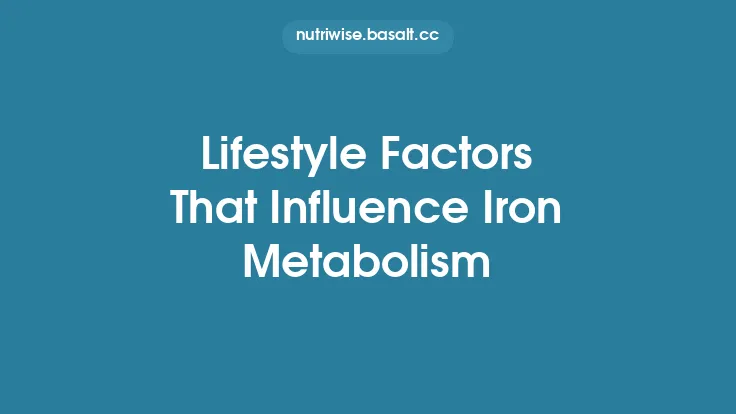Nutrient bioaccessibility—the proportion of a nutrient that is released from the food matrix during digestion and becomes available for absorption—depends on a complex interplay of factors that begin the moment food enters the mouth and continue through the small intestine. While the ultimate absorption of a nutrient is also shaped by physiological transport mechanisms, the focus here is on the upstream determinants that dictate how much of a given nutrient actually reaches the absorptive surface in a form that can be taken up. Understanding these determinants helps us appreciate why the same food can provide different nutritional yields under varying conditions, and it offers practical insight for everyday meal planning without venturing into the more specialized realms of food‑processing technology, cooking‑method optimization, or targeted mineral‑pairing strategies.
Chemical Form and Solubility of Nutrients
The intrinsic chemical nature of a nutrient is perhaps the most fundamental driver of its bioaccessibility. Nutrients exist in multiple forms, each with distinct solubility, stability, and reactivity profiles:
- Minerals: Elements such as iron, zinc, and calcium can be present as inorganic salts (e.g., FeSO₄, CaCO₃) or bound within organic complexes (e.g., phytate‑bound iron, calcium‑oxalate). The more soluble ionic forms dissolve readily in gastric fluids, whereas insoluble complexes may remain largely undissolved, limiting their availability for transport across the intestinal epitheli cell.
- Vitamins: Water‑soluble vitamins (B‑complex, vitamin C) are generally stable in the aqueous environment of the gastrointestinal tract, but their bioaccessibility can be compromised by oxidation or pH‑dependent degradation. Fat‑soluble vitamins (A, D, E, K) require incorporation into mixed micelles—a process that hinges on their ability to partition into lipid phases.
- Proteins and Peptides: The primary structure (amino‑acid sequence) influences susceptibility to proteolysis. Certain amino‑acid residues (e.g., cysteine) can form disulfide bonds that resist enzymatic cleavage, while others (e.g., proline‑rich sequences) may hinder pepsin activity.
- Carbohydrates: Simple sugars are instantly soluble, whereas complex polysaccharides must be broken down by amylases and brush‑border enzymes. The degree of polymerization and branching affect the rate and extent of hydrolysis.
In everyday meals, the same nutrient may appear in multiple chemical guises. For instance, calcium in dairy (as calcium‑caseinate) is more soluble than calcium in fortified plant milks (often as calcium carbonate). Recognizing these differences helps explain why certain foods are more efficient nutrient sources despite comparable total content.
Particle Size and Physical State of Foods
Mechanical breakdown—chewing, grinding, and the subsequent mixing with saliva—creates a particle size distribution that directly influences the surface area exposed to digestive enzymes and gastric fluids. Smaller particles dissolve faster, increasing the concentration gradient that drives diffusion into the lumen. Several points illustrate this principle:
- Mouth‑Phase Disintegration: Adequate mastication not only reduces particle size but also mixes food with salivary amylase, initiating carbohydrate digestion. Insufficient chewing can leave larger aggregates that resist gastric acid penetration, especially for fibrous plant tissues.
- Food Form (Solid vs. Liquid): Liquids inherently present nutrients in a dispersed state, facilitating rapid gastric emptying and immediate exposure to intestinal enzymes. Solid foods, particularly those with dense matrices (e.g., nuts, seeds), require more extensive mechanical and chemical breakdown before nutrients become bioaccessible.
- Emulsification: For lipid‑containing foods, the creation of fine oil droplets (via mechanical shearing or natural emulsifiers like lecithin) dramatically expands the interfacial area for lipase action and subsequent micelle formation. Even in the absence of added emulsifiers, the natural phospholipid content of egg yolk or soy can aid this process.
Thus, the physical state of a meal—how finely it is chopped, blended, or chewed—modulates the kinetic window during which nutrients become solubilized and ready for absorption.
Gastric Environment: pH and Enzyme Activity
The stomach provides the first chemically aggressive milieu that many nutrients must traverse. Two interrelated aspects dominate:
- Acidic pH (≈1.5–3.5): Low pH promotes the dissolution of many mineral salts (e.g., calcium carbonate → calcium ions + CO₂). It also denatures protein structures, exposing peptide bonds to pepsin. However, overly acidic conditions can degrade pH‑sensitive vitamins (e.g., vitamin C) through oxidation, reducing their bioaccessibility.
- Pepsin and Gastric Lipase: Pepsin cleaves peptide bonds preferentially at aromatic residues, generating smaller peptides that are more amenable to pancreatic proteases later. Gastric lipase, though modest in activity, initiates triglyceride hydrolysis, especially for medium‑chain fatty acids that are readily absorbed. The efficiency of these enzymes depends on adequate gastric secretion, which can be compromised by age, certain medications (e.g., proton‑pump inhibitors), or chronic gastritis.
The duration of gastric residence further influences bioaccessibility. Longer gastric emptying times allow more extensive mineral solubilization and protein hydrolysis, whereas rapid emptying may deliver partially digested particles to the duodenum, limiting the opportunity for complete nutrient release.
Role of Lipids and Bile in Fat‑Soluble Nutrient Bioaccessibility
Fat‑soluble vitamins and certain phytonutrients (e.g., carotenoids) rely on a cascade of lipid‑mediated processes to become bioaccessible:
- Emulsification by Bile Salts: Upon entry into the duodenum, bile salts act as natural surfactants, breaking down dietary fat globules into micelles. The amphipathic nature of bile salts stabilizes these structures, allowing lipophilic molecules to partition into the micellar core.
- Mixed Micelle Formation: Micelles incorporate fatty acids, monoglycerides, cholesterol, and fat‑soluble vitamins. Their size (≈10 nm) enables diffusion through the unstirred water layer adjacent to the enterocyte surface.
- Enterocyte Uptake: Specific transport proteins (e.g., NPC1L1 for cholesterol, SR-BI for vitamin E) facilitate the transfer of micellar constituents into the cell. Once inside, vitamins are incorporated into chylomicrons for lymphatic transport.
The quantity and type of dietary fat influence micelle efficiency. Long‑chain triglycerides (LCTs) generate larger micelles that can carry more vitamin molecules, whereas medium‑chain triglycerides (MCTs) are absorbed directly and provide less micellar capacity. Consequently, a modest amount of dietary fat (≈5–10 g) is often sufficient to maximize the bioaccessibility of fat‑soluble nutrients in a typical meal.
Interactions Among Nutrients and Competitive Transport
Nutrients do not exist in isolation within the intestinal lumen; they can compete for the same transport pathways or influence each other’s solubility:
- Competitive Inhibition at Transporters: For example, the divalent metal transporter 1 (DMT1) mediates uptake of iron (Fe²⁺) and also transports other divalent cations such as manganese and zinc. High concentrations of one can suppress the absorption of the other.
- Complex Formation: Certain nutrients can chelate each other, forming complexes that are either more soluble (e.g., ascorbic acid reducing ferric to ferrous iron) or less soluble (e.g., calcium binding oxalate). While the former can enhance bioaccessibility, the latter reduces it.
- pH‑Dependent Solubility Shifts: The presence of acidic foods can lower luminal pH, increasing solubility of minerals that are otherwise poorly soluble at neutral pH. Conversely, alkaline foods may precipitate calcium phosphate, limiting its availability.
Understanding these interactions helps explain why the same nutrient may be more or less bioaccessible depending on the overall composition of the meal, even when the individual food items remain unchanged.
Influence of Meal Timing, Frequency, and Gastric Emptying
The temporal pattern of eating exerts subtle but measurable effects on nutrient bioaccessibility:
- Meal Size: Large meals delay gastric emptying, extending the period during which gastric acid can act on minerals and proteins. This can improve the solubilization of certain nutrients but may also lead to incomplete mixing of bile with the chyme, potentially reducing micelle formation for fat‑soluble vitamins.
- Inter‑Meal Intervals: Consuming a nutrient‑dense snack shortly after a main meal can result in overlapping gastric phases, where the second intake experiences a partially neutralized gastric environment, possibly diminishing mineral dissolution.
- Circadian Variations: Gastric acid secretion exhibits diurnal rhythms, with peak acidity in the early evening. Consequently, the same meal consumed at different times of day may experience varying degrees of mineral solubilization.
These dynamics underscore the importance of considering not just *what is eaten, but when and how* it is consumed.
Individual Physiological Factors: Age, Health Status, and Genetics
Even with identical meals, individuals can experience markedly different bioaccessibility outcomes due to intrinsic physiological variables:
- Age‑Related Changes: Elderly individuals often exhibit reduced gastric acid secretion (hypochlorhydria) and diminished pancreatic enzyme output, both of which can lower the dissolution of minerals and the hydrolysis of proteins.
- Health Conditions: Diseases such as celiac sprue, inflammatory bowel disease, or chronic pancreatitis impair the absorptive surface area or enzyme availability, directly affecting the conversion of nutrients into bioaccessible forms.
- Genetic Polymorphisms: Variants in genes encoding transport proteins (e.g., SLC23A1 for vitamin C, SLC5A1 for glucose) can alter the efficiency of nutrient uptake after bioaccessibility has been achieved. While these genetic factors pertain more to absorption than to bioaccessibility per se, they can create feedback loops that influence digestive secretions and motility.
Recognizing these personal factors is essential for interpreting variability in nutritional outcomes across populations.
Impact of Food Temperature and Moisture Content
Temperature and water activity, often overlooked, can modulate the physicochemical environment of the gastrointestinal tract:
- Temperature: Warm foods (≈37–45 °C) can increase the rate of enzymatic reactions and enhance solubility of certain nutrients, such as lipids, by reducing viscosity. Conversely, very hot foods may denature heat‑sensitive vitamins before they reach the stomach.
- Moisture Content: High‑water foods (soups, stews) provide an immediate aqueous medium that facilitates rapid dissolution of water‑soluble nutrients. Dry foods (crackers, nuts) rely on saliva and gastric fluids to hydrate before solubilization can occur, potentially delaying nutrient release.
These factors are especially relevant for meals that combine both hot and cold components, as the temperature gradient can affect the timing of nutrient release within the digestive tract.
Practical Strategies for Enhancing Bioaccessibility in Everyday Meals
While the preceding sections outline the mechanistic underpinnings, a few straightforward practices can help maximize the proportion of nutrients that become bioaccessible in typical home‑cooked or commercially prepared meals:
- Chew Thoroughly: Aim for 20–30 chews per bite of solid foods to reduce particle size and promote early enzymatic action.
- Incorporate a Small Amount of Healthy Fat: Adding a teaspoon of olive oil, a few nuts, or a slice of avocado to meals rich in fat‑soluble vitamins (e.g., salads with carrots or leafy greens) supports micelle formation without excessive caloric load.
- Pair Acidic Elements with Mineral‑Rich Foods: A splash of lemon juice on leafy greens or a side of tomato sauce with beans can modestly lower luminal pH, aiding mineral dissolution.
- Avoid Over‑Processing at the Table: While pre‑grated cheese or finely milled flours are convenient, they may already be in a highly soluble state, reducing the need for further mechanical breakdown. Balance such items with coarser textures to stimulate chewing.
- Mind Meal Timing: If you have a known issue with low stomach acid, consider spacing mineral‑dense meals (e.g., calcium‑rich dairy) away from large, high‑fat dishes to allow adequate gastric exposure.
- Stay Hydrated: Adequate fluid intake ensures sufficient aqueous medium for nutrient dissolution and transport, especially for water‑soluble vitamins and minerals.
- Consider Temperature: Serve foods at a moderate temperature (warm, not scalding) to preserve heat‑sensitive nutrients while still benefiting from enhanced solubility.
By integrating these habits into daily eating patterns, most individuals can improve the efficiency with which their bodies access the nutrients embedded in everyday foods, without resorting to specialized processing techniques or elaborate dietary regimens.





